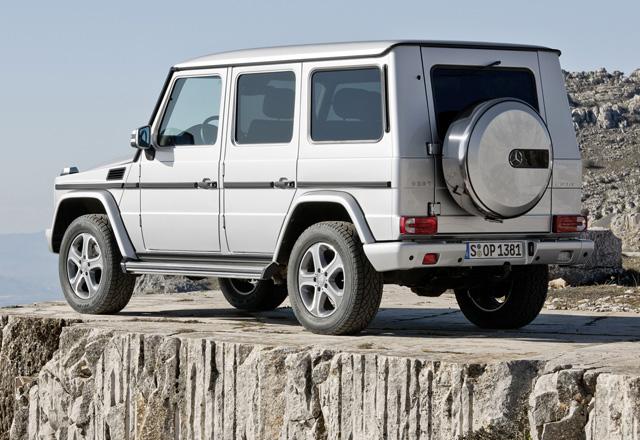You are here
Mercedes-AMG G63: Last hurrah!
By Ghaith Madadha - May 27,2019 - Last updated at May 27,2019

Photo courtesy of Mercedes-Benz
Beginning life as a quasi-military machine developed in cooperation with off-road specialists Steyr-Daimler-Puch and at the behest of then major Mercedes-Benz shareholder Shah Reza Pahlavi, the Mercedes G-Class got off to a rocky start in 1979 just as the Shah was toppled, leaving a stock of pre-ordered G-Classes unsold. Since then, the boxy G-Class has become Mercedes’ longest serving platform and modern automotive icon, whose continual development was largely driven by its position as status symbol in the Arabian Gulf.
Little altered in its basic and highly off-road biased underpinnings and defiantly un-aerodynamic shape, yet constantly upgraded in terms of luxury, amenities and performance, the G-Class biggest departure came with last year’s new and larger model. Ditched the G-Class traditional and distinctive front live axle suspension and adopting a softer edged design that seemed almost apologetic at the front headlights, the new G-Class finally may be more technologically advanced, comfortable and refined with its concessions to modernity, but seems to lack its predecessor’s old school charm.
Desirable and defiant to end
A gloriously defiant dinosaur the likes of which we’ll likely not see again, the last iteration original G-Class, circa 2016-18, spawned truly excessive six-wheel-drive, raised and twin-turbo V12 versions as last hurrahs courtesy of Mercedes-Benz’s inhouse AMG tuning division and primarily catering to the Gulf. However, it was most iconic and desirable in standard high performance AMG G63 guise, where it reached its apogee of development and authenticity. No longer manufactured, but soon to become highly sought after, the outgoing G63 could probably still be sourced from independent or maybe even official traders and dealerships.
Improved for more performance and enhanced efficiency since its 2016 face-lift, the G63’s twin-turbocharged direct injection 5.5-litre V8 engine is a brutal powerhouse developing 563BHP at 5,500rpm and 561lb/ft throughout a 1,750-5,000rpm mid-range sweet spot. Driving all wheels with even front-to-rear distribution through a 7-speed automatic gearbox, the G63 digs in to tarmac and propels its 2,550kg mass through 0-100km/h is scant 5.4-seconds. Epic at full chat and flexibly mighty in mid-range, the G63’s defies its un-aerodynamic design at speed and returns reduced, but still thirsty 13.8l/100km fuel consumption.
Unimpeachable off-roader at heart
Designed with brutal upright lines, sharp angles and box-like shape to maximise space and driving visibility in confined conditions, the G63 is unapologetically utilitarian and features exposed door hinges, dual side exhaust ports, flat wheel-arch flares and surfaces, including a flat wind screen. That given, the G63’s top speed is limited to 210km/h, and it is more susceptible to wind-buffeting at speed than modern aerodynamically-design SUVs. More aggressive with AMG bumpers and wider, lower profile 275/50R20 tyres, the G63’s extensive off-road capability is slightly compromised next to non-AMG G-Class versions.
Riding lower than garden-variety G-Classes, the G63’s 196mm ground clearance, 600mm water fording, equal 27 degrees approach and departure angles, 54 per cent lateral angle and 80 per cent climbing rate are generous, while low gear ratios allow maximum power driving at crawling pace. But most formidable are its rugged all-round live-axle suspension, and fully and individually locking rear, centre and front differentials. Deployed as needed over the loosest surfaces and harshest terrain, the G63 becomes near unstoppable and continue driving even if only one wheel has traction, when all three differentials are locked.
Updated and integrated
More forgiving, refined and stable than expected, the G63’s all-round live axle suspension that makes it a legendary off-roader, however, reduces its on-road comfort and agility. The G63’s front live axle set-up is an automotive rarity that means that a wheel on one side reacts in an equal and opposite manner in vertical travel and camber to the other side, and so feels busy and less grounded through corners and over road undulations. Generating good grip, the G63 is not as fluent being hustled though quick country switchbacks as Mercedes’ more sophisticated independent suspension SUVs.
Featuring reassuringly alert electronic stability controls and light if slightly vague and long steering, the G63 is an easy drive. Visibility is meanwhile excellent owing to a big glasshouse, boxy uniform shape and upright driving position near the doors. If somewhat old school in its cabin shape and driving position, the G63 is nevertheless luxuriously finished and equipped, with quality leathers, woods, safety, infotainment and convenience features and designs updated to best integrate it its cabin ambiance, refinement and sophistication to other contemporary Mercedes luxury models built on modern platforms.
TECHNICAL SPECIFICATIONS
Engine: 5.5-litre, 32-valve, twin-turbocharged V8-cylinders
Bore x Stroke: 98 x 90.5mm
Compression ratio: 10:1
Gearbox: 7-speed automatic, four-wheel-drive
Drive-line: Locking centre, rear & front differentials, low ratio transfer case
Power distribution, F:R: 50:50 per cent
Gear ratios: 1st 4.38; 2nd 2.86; 3rd 1.92; 4th 1.37; 5th 1.0; 6th 0.82; 7th 0.73; R1 4.42; R2 2.23
Final drive: 3.58
Power, HP (PS) [kW]: 563 (571) [420] @5,500rpm
Specific power: 103BHP/litre
Power-to-weight: 220.7BHP/tonne
Torque lb/ft (Nm): 561 (760) @ 1750-5,000rpm
Specific torque: 139Nm/litre
Torque-to-weight: 298Nm/tonne
0-100 km/h: 5.4-seconds
Maximum speed: 210km/h
Fuel consumption, combined: 13.8 litres/100km
CO2 emissions: 322g/km
Length: 4,763mm
Width: 1,855mm
Height: 1,938mm
Wheelbase: 2,850mm
Track: 1,501mm
Headroom, F/R: 1,077/1,018mm
Legroom, F/R: 1,333/1,064mm
Shoulder room, F/R: 1,430/1,430mm
Luggage volume, min/max: 487-/2,126-litres
Ground clearance: 196mm
Fording depth: 600mm
Approach/departure angle: 27/27 degrees
Maximum lateral angle: 54 per cent
Maximum climbing grade: 80 per cent
Kerb weight: 2,550kg
Payload capacity: 650kg
Towing capacity, braked/unbraked: 3,500kg/750kg
Fuel capacity: 96-litres
Steering: Recirculating ball, hydraulic power assistance
Suspension, F&R: Live axle, coil springs, gas-charged dampers
Tyres: 275/50R20
Related Articles
An automotive icon and off-road legend, the Mercedes-Benz G-Class’ imminent demise has often been foretold, but reports of its death have invariably been greatly exaggerated.
A metaphorical mountain goat among SUVs, the Suzuki Jimny is an efficient, practical and uncomplicated vehicle that is thoroughly capable, m
Often associated with big, brawny and brutal SUVs and pick-ups, off-road driving is often better served with a small package.


















